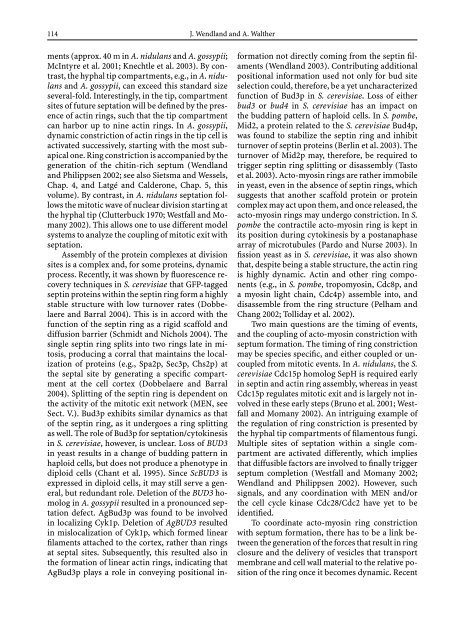Growth, Differentiation and Sexuality
Growth, Differentiation and Sexuality
Growth, Differentiation and Sexuality
You also want an ePaper? Increase the reach of your titles
YUMPU automatically turns print PDFs into web optimized ePapers that Google loves.
114 J. Wendl<strong>and</strong> <strong>and</strong> A. Walther<br />
ments (approx. 40 m in A. nidulans <strong>and</strong> A. gossypii;<br />
McIntyre et al. 2001; Knechtle et al. 2003). By contrast,<br />
the hyphal tip compartments, e.g., in A. nidulans<br />
<strong>and</strong> A. gossypii, can exceed this st<strong>and</strong>ard size<br />
several-fold. Interestingly, in the tip, compartment<br />
sites of future septation will be defined by the presence<br />
of actin rings, such that the tip compartment<br />
canharboruptonineactinrings.InA. gossypii,<br />
dynamic constriction of actin rings in the tip cell is<br />
activated successively, starting with the most subapical<br />
one. Ring constriction is accompanied by the<br />
generation of the chitin-rich septum (Wendl<strong>and</strong><br />
<strong>and</strong> Philippsen 2002; see also Sietsma <strong>and</strong> Wessels,<br />
Chap. 4, <strong>and</strong> Latgé <strong>and</strong> Calderone, Chap. 5, this<br />
volume). By contrast, in A. nidulans septation follows<br />
the mitotic wave of nuclear division starting at<br />
the hyphal tip (Clutterbuck 1970; Westfall <strong>and</strong> Momany<br />
2002). This allows one to use different model<br />
systems to analyze the coupling of mitotic exit with<br />
septation.<br />
Assembly of the protein complexes at division<br />
sites is a complex <strong>and</strong>, for some proteins, dynamic<br />
process. Recently, it was shown by fluorescence recovery<br />
techniques in S. cerevisiae that GFP-tagged<br />
septin proteins within the septin ring form a highly<br />
stable structure with low turnover rates (Dobbelaere<br />
<strong>and</strong> Barral 2004). This is in accord with the<br />
function of the septin ring as a rigid scaffold <strong>and</strong><br />
diffusion barrier (Schmidt <strong>and</strong> Nichols 2004). The<br />
single septin ring splits into two rings late in mitosis,<br />
producing a corral that maintains the localization<br />
of proteins (e.g., Spa2p, Sec3p, Chs2p) at<br />
the septal site by generating a specific compartment<br />
at the cell cortex (Dobbelaere <strong>and</strong> Barral<br />
2004). Splitting of the septin ring is dependent on<br />
the activity of the mitotic exit network (MEN, see<br />
Sect. V.). Bud3p exhibits similar dynamics as that<br />
of the septin ring, as it undergoes a ring splitting<br />
as well. The role of Bud3p for septation/cytokinesis<br />
in S. cerevisiae, however, is unclear. Loss of BUD3<br />
in yeast results in a change of budding pattern in<br />
haploid cells, but does not produce a phenotype in<br />
diploid cells (Chant et al. 1995). Since ScBUD3 is<br />
expressed in diploid cells, it may still serve a general,<br />
but redundant role. Deletion of the BUD3 homolog<br />
in A. gossypii resulted in a pronounced septation<br />
defect. AgBud3p was found to be involved<br />
in localizing Cyk1p. Deletion of AgBUD3 resulted<br />
in mislocalization of Cyk1p, which formed linear<br />
filaments attached to the cortex, rather than rings<br />
at septal sites. Subsequently, this resulted also in<br />
the formation of linear actin rings, indicating that<br />
AgBud3pplaysaroleinconveyingpositionalin-<br />
formation not directly coming from the septin filaments<br />
(Wendl<strong>and</strong> 2003). Contributing additional<br />
positional information used not only for bud site<br />
selection could, therefore, be a yet uncharacterized<br />
function of Bud3p in S. cerevisiae. Lossofeither<br />
bud3 or bud4 in S. cerevisiae has an impact on<br />
the budding pattern of haploid cells. In S. pombe,<br />
Mid2,aproteinrelatedtotheS. cerevisiae Bud4p,<br />
was found to stabilize the septin ring <strong>and</strong> inhibit<br />
turnover of septin proteins (Berlin et al. 2003). The<br />
turnover of Mid2p may, therefore, be required to<br />
trigger septin ring splitting or disassembly (Tasto<br />
et al. 2003). Acto-myosin rings are rather immobile<br />
in yeast, even in the absence of septin rings, which<br />
suggests that another scaffold protein or protein<br />
complex may act upon them, <strong>and</strong> once released, the<br />
acto-myosin rings may undergo constriction. In S.<br />
pombe the contractile acto-myosin ring is kept in<br />
its position during cytokinesis by a postanaphase<br />
array of microtubules (Pardo <strong>and</strong> Nurse 2003). In<br />
fission yeast as in S. cerevisiae, it was also shown<br />
that, despite being a stable structure, the actin ring<br />
is highly dynamic. Actin <strong>and</strong> other ring components<br />
(e.g., in S. pombe, tropomyosin, Cdc8p, <strong>and</strong><br />
a myosin light chain, Cdc4p) assemble into, <strong>and</strong><br />
disassemble from the ring structure (Pelham <strong>and</strong><br />
Chang 2002; Tolliday et al. 2002).<br />
Two main questions are the timing of events,<br />
<strong>and</strong> the coupling of acto-myosin constriction with<br />
septum formation. The timing of ring constriction<br />
may be species specific, <strong>and</strong> either coupled or uncoupled<br />
from mitotic events. In A. nidulans,theS.<br />
cerevisiae Cdc15p homolog SepH is required early<br />
in septin <strong>and</strong> actin ring assembly, whereas in yeast<br />
Cdc15p regulates mitotic exit <strong>and</strong> is largely not involved<br />
in these early steps (Bruno et al. 2001; Westfall<br />
<strong>and</strong> Momany 2002). An intriguing example of<br />
the regulation of ring constriction is presented by<br />
the hyphal tip compartments of filamentous fungi.<br />
Multiple sites of septation within a single compartment<br />
are activated differently, which implies<br />
that diffusible factors are involved to finally trigger<br />
septum completion (Westfall <strong>and</strong> Momany 2002;<br />
Wendl<strong>and</strong> <strong>and</strong> Philippsen 2002). However, such<br />
signals, <strong>and</strong> any coordination with MEN <strong>and</strong>/or<br />
the cell cycle kinase Cdc28/Cdc2 have yet to be<br />
identified.<br />
To coordinate acto-myosin ring constriction<br />
with septum formation, there has to be a link between<br />
the generation of the forces that result in ring<br />
closure <strong>and</strong> the delivery of vesicles that transport<br />
membrane <strong>and</strong> cell wall material to the relative position<br />
of the ring once it becomes dynamic. Recent

















